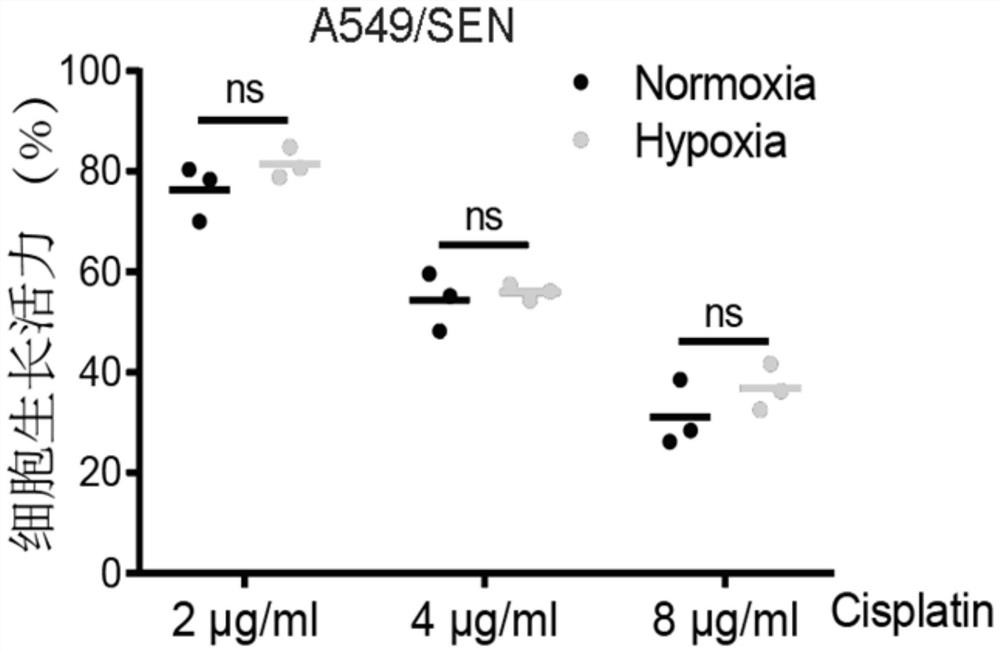Application of targeted exosome PKM2 in improvement of cisplatin resistance of non-small cell lung cancer (NSCLC)
A non-small cell lung cancer, PKM2 technology, applied in the biological field, can solve problems such as hindering the treatment effect, and achieve the effect of enhancing chemotherapy sensitivity, inducing cell apoptosis, and improving cisplatin resistance.
- Summary
- Abstract
- Description
- Claims
- Application Information
AI Technical Summary
Problems solved by technology
Method used
Image
Examples
Embodiment 1
[0074] Example 1 Induction of cisplatin-resistant cells and detection of cisplatin resistance under hypoxic conditions
[0075] (1) Use non-small cell lung cancer cell A549 as the parental cell line, add cisplatin to the final concentration of 2ng / ml each time of subculture, and then repeat the subculture and dosing until the cells basically adapt to no death, and gradually increase the concentration of cisplatin , cisplatin-resistant cell line A549 / CR was obtained after 10 months.
[0076] (2) Detect the half inhibitory rate (IC50) of cisplatin in the sensitive cell A549 and drug-resistant cell A549 / CR. First, the survival rate and inhibition rate of each cell at each concentration are obtained by the CCK8 method, and then the cisplatin half inhibitory rate is obtained by Graphpad Prism 7 The software makes an inhibitory dose-response curve with a variable slope, and calculates the IC50 value. The results are shown in Figure 1A .
[0077] (3) The method for CCK8 to detect t...
Embodiment 2
[0079] Example 2 Overexpression of PKM2 in Sensitive Cells and Detection of Cell Proliferation
[0080] (1) The coding sequence of the PKM2 gene (SEQ ID NO: 1) was cloned into the pcDNA4TO-Flag vector, and a plasmid overexpressing PKM2 was obtained after confirmation by sequencing. The extraction of the plasmid was carried out according to the instructions of the reagent manufacturer.
[0081] (2) Sensitive cells A549 were planted in 6-well plate 4×10 5 Each cell / well was transfected with 2 μg of PKM2 overexpression plasmid or control empty plasmid, respectively. After 24 hours the cells were digested and the cells were pressed for 10 4 Cells / well were seeded into 96-well plates, and the cell proliferation was detected by the method of CCK8.
[0082] (3) Cell proliferation was detected by the clone formation method. The specific method was as follows: 200 cells / well of the sensitive cell A549 were planted in a 12-well plate, transfected with 1 μg of PKM2 overexpression plasm...
Embodiment 3
[0083] Example 3 Knockdown of PKM2 in drug-resistant cells and detection of cell proliferation
[0084] (1) Design two shRNA sequences targeting PKM2 (shRNA sequence #1 is SEQ ID NO:2 and SEQ ID NO:3, shRNA sequence #2 is SEQ ID NO:4 and SEQ ID NO:5), and synthesize DNA The fragment was inserted into the LV3 shuttle vector to obtain a shuttle plasmid carrying the PKM2 shRNA sequence. The shuttle plasmid and packaging plasmid (pGag / Pol, pRev, pVSV-G) were co-transfected into 293T cells, and the lentivirus in the supernatant was collected 72 hours after transfection and the virus titer was measured.
[0085] (2) The lentivirus carrying the PKM2 shRNA sequence was infected into drug-resistant cells A549 / CR, and the A549 / CR cell line stably knocking down PKM2 was obtained by puromycin selection.
[0086] (3) A549 / CR cells stably knocking down PKM2 and control cells were mixed at 10 per well 4 Cells were inoculated into 96-well plates for CCK8 experiments, and 200 cells per well ...
PUM
 Login to View More
Login to View More Abstract
Description
Claims
Application Information
 Login to View More
Login to View More - R&D Engineer
- R&D Manager
- IP Professional
- Industry Leading Data Capabilities
- Powerful AI technology
- Patent DNA Extraction
Browse by: Latest US Patents, China's latest patents, Technical Efficacy Thesaurus, Application Domain, Technology Topic, Popular Technical Reports.
© 2024 PatSnap. All rights reserved.Legal|Privacy policy|Modern Slavery Act Transparency Statement|Sitemap|About US| Contact US: help@patsnap.com










